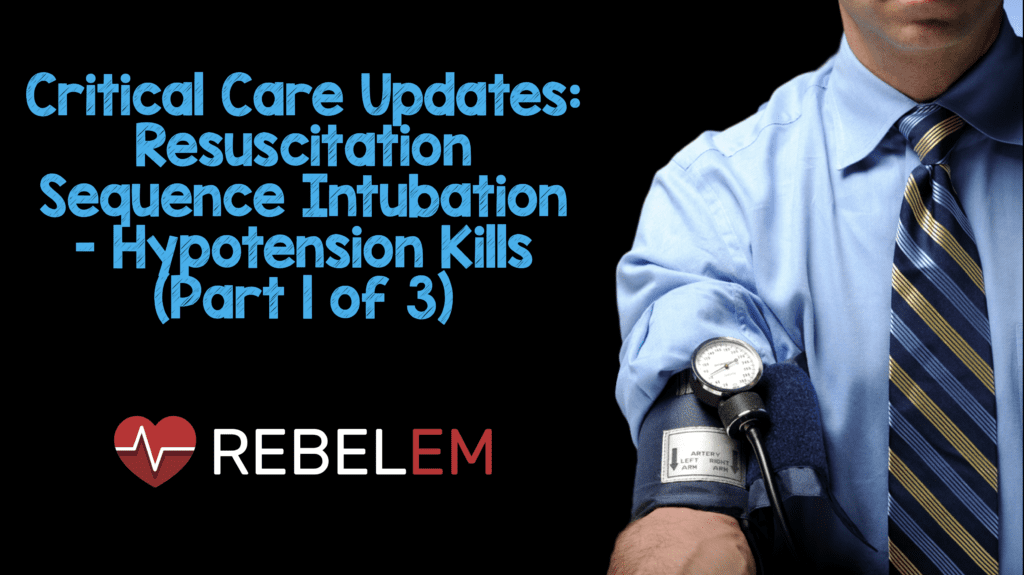
What was the Premise of this Talk?
- Resuscitate Before You Intubate
- Hefner AC et al [1] and Kim WY et al [2] evaluated over 2800 patients requiring emergency intubation. In both trials the rate of cardiac arrest (CA) within 10 minutes of intubation ranged from 1.7% – 2.4%. Both trials listed pre-intubation hypotension (SBP ≤90mmHg) as a risk factor for cardiac arrest. Hefner et al also mentioned hypoxemia as an important risk factor.
What are the Physiologic Killers Pre-intubation/Peri-intubation?
- HOp Killers (Credit to Scott Weingart at emcrit.org)
- Hypotension
- Hypoxemia (Hypoxemia Kills – Part 2 of 3)
- Metabolic Acidosis (pH) (pH Kills – Part 3 of 3)
Hypotension Kills
- Schwartz DE et al [3] published a prospective study in Anesthesiology 1995 which stated that pre-intubation hypotension was the biggest predictor of CA. So what are some strategies that we can use to avoid this?
- Basic Strategies:
- At least 2 proximal peripheral IVs (PIVs)
- If unable to get PIVs, IO can be used as well for RSI [4] [5]
- 1 – 2L of Crystalloid IVF wide open
- Shoot for a higher than normal BP before intubating if possible (SBP ≥140mmHg)
- Intervention 1: Sedatives Low & Paralytics High [6]
- Doses of induction agents and paralytics should be adjusted according to pre-RSI physiology. This means reducing the dose of your induction agent and increasing the dose of your paralytic agent for several reasons:
- Induction agents can drop BP in shock patients by decreasing vascular tone and reducing venous return [11]
- Some induction agents will decrease sympathetic tone (i.e. Benzodiazepines, Propofol) [11]
- Changing patient from NPV to PPV will decrease venous return
- Paralytics take longer to work in a shock state (cardiac output dependent)
- Shock by itself is a powerful anesthetic
- Ketamine should be the induction agent of choice in shock patients (Gives simultaneous sympathetic surge and pain control).
- Dissociative dose is 1 – 2mg/kg IV, but in shock patients reduce this dose to 0.5mg/kg IV. Patients may require subsequent doses of of 0.5mg/kg prior to paralytics being given (be sure patient is completely sedated before pushing paralytic).
- Rocuronium should be the paralytic agent of choice. Succinylcholine possesses the fastest onset (45sec) and produces the shortest period of muscle relaxation (6 – 10min) compared to all other paralytic agents at standard doses. However, Rocuronium dosed at 1.6mg/kg IV (Link is HERE), gives the same onset of muscle relaxation as succinylcholine [7] and gives a longer safe apnea time [8] making it the preferred paralytic of choice in the critically ill.
- Rocuronium 1.6mg/kg IV
- Succinylcholine 2mg/kg IV
- At the Social Media And Critical Care (SMACC) Conference in 2013, Cliff Reid called this combination of low dose Ketamine and higher dose rocuronium, ROCKETamine
- Bottom Line: In the critically ill patient and shock state, a physiologically sound combination for induction and paralysis in RSI is ROCKETamine (Ketamine 0.5mg/kg IV + additional doses of 0.5mg/kg until pt is fully sedated + Rocuronium 1.6mg/kg IV)
- Doses of induction agents and paralytics should be adjusted according to pre-RSI physiology. This means reducing the dose of your induction agent and increasing the dose of your paralytic agent for several reasons:
- Intervention 2a: Push Dose Pressors
- Prevents delays in intubation that may lead to increased morbidity and mortality
- Paschal AR et al [9] did 119 intubations, with nearly 25% of patients requiring push dose phenylephrine. The observed result was improved hemodynamics during the peri-intubation period
- Epinephrine should be the pressor agent of choice to give push dose because it possesses, both an alpha and beta agonist, as this not only increases vascular resistance and blood pressure, but through its beta agonist effect also increases cardiac output.
- Phenylephrine, a pure alpha agonist (i.e. potent vasoconstrictor) increases vascular resistance and blood pressure, but will decrease cardiac output and venous return due to the lack of effect at the beta receptors.
- Scott Weingart has a great podcast on Push Dose Pressors that can be found HERE
- Mixing and Dosing of Push Dose Epinephrine:
- Take a 10cc syringe of NS and get rid of 1cc (9cc left in syringe)
- Draw up 1cc of Code Dose Epinephrine (100mcg/mL)
- This gives you 10mcg/mL of Epinephrine
- Dosing: 0.5 – 2mL (5 – 20mcg) q2 – 5minutes
- Bottom Line: In the critically ill patient and shock state, another option to improve hemodynamics both pre-intubation and peri-intubation is push dose epinephrine
- Intervention 2b: Peripheral Pressors
- Listed separately because although, also prevents delays in intubation but may take longer to get pumps/channels/mix pressor drip
- The largest review to date on the safety of pressors run through a PIV was done by Lubani et al [10]. This was 85 articles with 270 patients. They looked at extravasation events versus time and recorded their observations:
- 85.3% of extravasation events occurred in PIVs distal to the antecubital and or popliteal fossae
- 96.8% of extravasation events occurred in infusions running >4hrs
- Bottom Line: In critically ill patients, with hemodynamic instability, vasopressor infusion through a proximal PIV (antecubital fossa or external jugular vein), for 4hours of duration is unlikely to result in tissue injury and will reduce the time it takes to achieve hemodynamic stability
- Intervention 3: Awake Intubation
- By keeping the patient awake, they maintain their endogenous catecholamines that may be suppressed by induction agents, thus allowing for increased cardiac output and maintenance of vascular tone, ultimately helping increase venous return
- I had never heard or tried this until I listened to a podcast on EMCrit found HERE
- How is an Awake Intubation Done:
- Spray 10cc of 4% lidocaine into the oropharynx with an EZ-Atomizer
- Apply at least 2 – 4% Topical Lidocaine to the posterior tongue with a tongue depressor
- Spray another 5cc of 4% lidocaine just past the vocal cords
- Now intubate you awake patient
- Bottom Line: In the critically ill patient and shock state, another option if time permits is the awake intubation
Clinical Bottom Line:
- Pre-Intubation Hypotension (SBP ≤90mmHg) is a risk factor for Peri-Intubation Cardiac Arrest:
- Options to Improve Hemodynamics:
- Don’t Forget the Basics (i.e. IVF)
- Intervention 1: Use ROCKETamine, Dose Induction Agents Low and Paralytic Agents High
- Intervention 2a: Use Push Dose Epinephrine
- Intervention 2b: Use Peripheral Vasopressors Prior to Intubation
- Intervention 3: If Time Permits, Perform the Awake Intubation
- Many of these interventions can be done simultaneously to ensure no hemodynamic instability
Credit to Scott Weingart (Twitter: @EMCrit) for creating the HOp Killers mnemonic.
For More on These Topics Checkout:
- Scott Weingart at EMCrit: The Hop Mnemonic and AirwayWorld.com Next Week
- Scott Weingart at EMCrit: Podcast 6 – Push-Dose Pressors
- Scott Weingart at EMCrit: Podcast 104 – Laryngoscope as a Murder Weapon (LAMW) Series – Hemodynamic Kills
- Scott Weingart at EMCrit: Podcast 107 – Peripheral Vasopressor Infusions and Extravasation
- Scott Weingart at EMCrit: Rapid Sequence Awake – An Awake Intubation Update
- Salim Rezaie at REBEL EM: Mythbuster – Administration of Vasopressors Through Peripheral Intravenous Access
References:
- Heffner AC et al. Incidence and factors associated with cardiac arrest complicating emergency airway management. Resuscitation 2013; 84(11): 1500 – 4. PMID: 23911630
- Kim WY et al. actors Associated with the Occurrence of Cardiac Arrest after Emergency Tracheal Intubation in the Emergency Department. Plos One 2014; 9(11): e112779. PMID: 25402500
- Schwartz DE et al. Death and Other Complications of Emergency Airway Management in Critically ill Adults. A Prospective Investigation of 297 Tracheal Intubations. Anesthesiology 1995; 82(2): 367 – 76. PMID: 7856895
- Barnard EBG et al. Rapid sequence induction of anaesthesia via the intraosseous route: a prospective observational study. Emerg Med J. 2014. PMID: 24963149
- Reades R et al. Intraosseous versus intravenous vascular access during out-of-hospital cardiac arrest: a randomized controlled trial. Ann Emerg Med. 2011;58(6):509-516. PMID: 21856044
- Reich DL et al. Predictors of hypotension after induction of general anesthesia. Anesth Analg. 2005; 101(3): 622 – 8. PMID: 16115962
- Curley GF. Rapid sequence induction with rocuronium – a challenge to the gold standard. Crit Care. 2011; 15(5): 190. PMID: 22112346
- Taha SK et al. Effect of suxamethonium vs rocuronium on onset of oxygen desaturation during apnoea following rapid sequence induction. Anesthesia 2010; 65(4): 358 – 61. PMID: 20402874
- Panchal AR et al. Efficacy of Bolus-Dose Phenylephrine for Peri-Intubation Hypotension. JEM 2015; 49(4): 488 – 94. PMID: 26104846
- Loubani et al. A systematic review of extravasation and local tissue injury from administration of vasopressors through peripheral intravenous catheters and central venous catheters. Journal of Critical Care 2015; 30(3): 653.39 – 17. PMID: 2566952
- Mosier JM et al. The Physiologically Difficult Airway. WJEM 2015; 16(7): 1109 – 17. PMID: 26759664
Post Peer Reviewed By: Anand Swaminathan (Twitter: @EMSwami)



